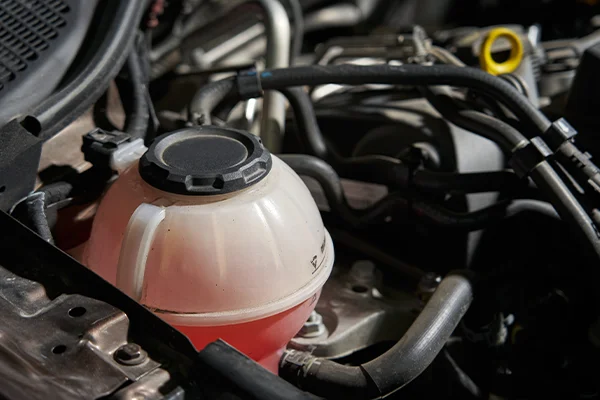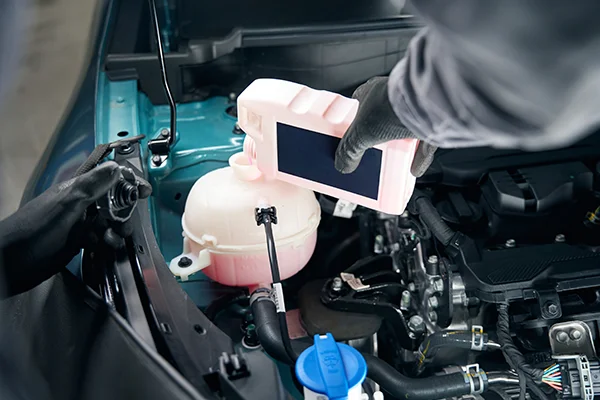A quick and friendly guide from the pros at Arvada Square Auto
You open the hood, glance at your coolant reservoir, and whoa. What is that murky mess floating in there? Don’t worry, you’re not alone. That goopy build-up is more common than you think. It’s also your engine’s way of saying: “Help!” You should also be concerned if you see build up residue at the ends of the radiator hoses as well as at the thermostat.
Luckily, the team at Arvada Square Auto is here to help you get to the bottom of it.

First Things First: What Is the Coolant Reservoir?
Your coolant reservoir is the clear plastic tank located near your radiator. It holds extra antifreeze (also called coolant), which helps regulate your engine’s temperature as it heats up and cools down. The coolant flows in and out of the system through this tank, maintaining balance as the fluid expands and contracts with temperature and pressure changes.
If that reservoir starts looking cloudy, rusty, or worse, like brown sludge or oily soup, that’s a clear sign something’s not right.
Why Does Gunk Build Up?
Here are the most common reasons:
1. Old Coolant That’s Gone Bad
Coolant naturally breaks down over time. As it ages, it becomes acidic and loses its anti-corrosive properties. The water content can also vaporize, which throws off the balance of glycol and H20. That leads to rust, scale, and deposits building up inside your cooling system. Eventually, all that grime ends up in the reservoir.
A proper coolant flush removes those harmful particles, restoring efficiency and protecting vital parts of your engine.
2. Mixing Different Types of Coolant
Mixing coolant types, like green with orange, can cause a chemical reaction that thickens into sludgy, gooey build-up. Different formulas aren’t always compatible. If you’re unsure what your vehicle takes, bring it to us and we’ll make sure it’s done right.

3. Oil or Transmission Fluid in the Coolant
If your coolant appears milky or greasy, it may indicate that oil or transmission fluid is mixing in. This is often caused by a blown head gasket or a leaking transmission cooler within the radiator. In fact, this issue led to lawsuits and a factory recall for certain Nissan models manufactured between 2000 and 2010. To learn more, consult our transmission experts at Advanced Transmission Center. This is not a DIY fix – bring your vehicle to the professionals at Arvada Square Auto for an immediate inspection.
4. Rust, Rubber, and Debris
Coolant travels through metal and rubber components, which can break down over time. Rust flakes, hose fragments, or rubber bits may find their way into the reservoir.
5. Combustion Gases Leaking In
If exhaust gases from the engine sneak into the cooling system through a faulty head gasket, it can cause bubbling, foaming, and weird sludge. The extra pressure can damage cooling components and lead to overheating, yet another reason why regular vehicle inspections matter. A damaged head gasket can be corrected if repaired quickly; if not, you could be left with an engine replacement. Damage found in your radiator and cooling system can be a sign that something else is wrong!
What Can You Do About It?
Start With a Coolant Flush
At Arvada Square Auto, we perform a thorough coolant flush to clear out buildup and prevent future problems. Here’s how it works:
- We begin by adding a Wynn’s cleaning additive to the old coolant. This breaks down sediment and grime stuck inside the system.
- Next, we use a specialized machine to completely flush out the old coolant while cycling in fresh, clean fluid.
- Finally, we add a second Wynn’s treatment that protects against corrosion and breakdown, helping your system run cleaner and cooler for longer.
Use the Right Coolant and Additives
Once the system’s clean, stick with the right type of coolant. Topping off with whatever’s lying around can cause more harm than good. We use trusted products like Wynn’s Coolant Booster to prevent rust, foam, and scale while enhancing cooling performance.
Address the Real Problem
If we spot signs of oil or combustion gases in your coolant, a flush alone won’t fix it. We’ll run diagnostics (like a pressure or block test) and give you a clear path forward, no guesswork, just honest answers. These are the type of recommendations you want to avoid from the nationally branded quick lube shop that typically lacks a certified and experienced technician.
How to Keep It Clean Moving Forward
- Flush the system every 2–5 years, or as recommended by your vehicle’s manual. We suggest more frequent maintenance if you’re a Colorado driver who frequently ventures into the mountains, as these conditions can place additional strain on your vehicle.
- Stick to one coolant type, no mixing or experimenting.
- Check the reservoir regularly for discoloration, cloudiness, or oily residue. Many systems are now “closed” so that there is no reservoir; in such cases look for residue buildup and discoloration of the coolant.
- Bring your car in if you notice overheating, bubbling, or strange smells.
Ready to Clear the Gunk?
The coolant reservoir may be small, but it plays a big role in keeping your engine healthy. Whether your system needs a simple flush or a more in-depth repair, Arvada Square Auto has you covered.
We offer complete inspections, professional cooling system service, and proven products like Wynn’s additives to keep your engine running clean and cool. This could be the most economic maintenance activity to avoid an expensive vehicle repair down the road.
Coolant System Maintenance in Arvada, Colorado
Think your coolant is looking a little funky?
Stop by Arvada Square Auto in Arvada, CO or give us a call today to secure your cooling system check. We’ll clean out the gunk and get you back on the road, smooth, safe, and stress-free.
